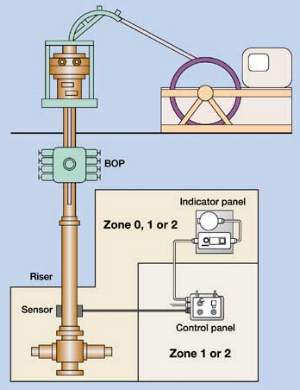01-02_technology-staff_4.htm (Feb-2001)
TECHNOLOGY AT WORKEnd-of-coiled-tubing detector systemToni Miszewski, AnTech Ltd., Exeter, UK The AnTech End-of-CT Detector is a wellhead sensor designed to assist oilfield service providers involved in running slimhole tools. This new system improves safety during CT operations. A warning system helps to prevent the problem of broken tubing accidentally being pulled through the stripper, which can result in serious and costly accidents. The solution is a sensor, strapped around the wellhead riser, that detects the passing end of coiled tubing and relays a signal to the cabin to give both a visual and audible warning. The sensor and alarm are simple devices and are, therefore, suitable for use in hazardous area Zones 0, 1 and 2. The control panel is fully certified for use in Zone 1 hazardous areas since it is incorporated into an explosion proof enclosure. When the company set out to design a wellhead sensor that would offer a comprehensive warning system, criteria dictated that it not only had to relay an alarm immediately, it had to be integrated into the wellhead in a non-invasive manner. The resulting system is simple to operate and install. Operating principle. A magnet assembly creates a field that the sensor measures. As steel tubing within the riser passes the sensor, changes in the field indicate the presence or absence of tubing in the riser. The changes trigger an LED and a beeper in the indicator panel, warning that the end of CT is passing the sensor (see figure). A compensating circuit in the system automatically adjusts for the ambient magnetic field at the end of the wellhead.
The signal level that is detected depends on the specific combination of riser and coiled tubing sizes. The system can be used on CT of any diameter or thickness, while the operational range for the riser is up to 8-in. OD with a wall thickness up to 1 in. In addition, the tool is capable of operating in another mode that detects a magnetic sub in the tool string. This makes the system ideal for accurate positioning of tool-string components. System used offshore Scotland. Halliburton has
been operating the CT detector system in the North Sea, offshore Scotland, since 1999, when it carried out its
first trials. Since spring 2000, the oilfield-services provider has been using it in a fully operational
capacity on behalf of clients as an "at surface" depth-confirmation tool while carrying out
perforation services. The detector allows the company to accurately check its primary depth system when
returning to surface, as well as during deployment and retrieval of perforating guns.
|



